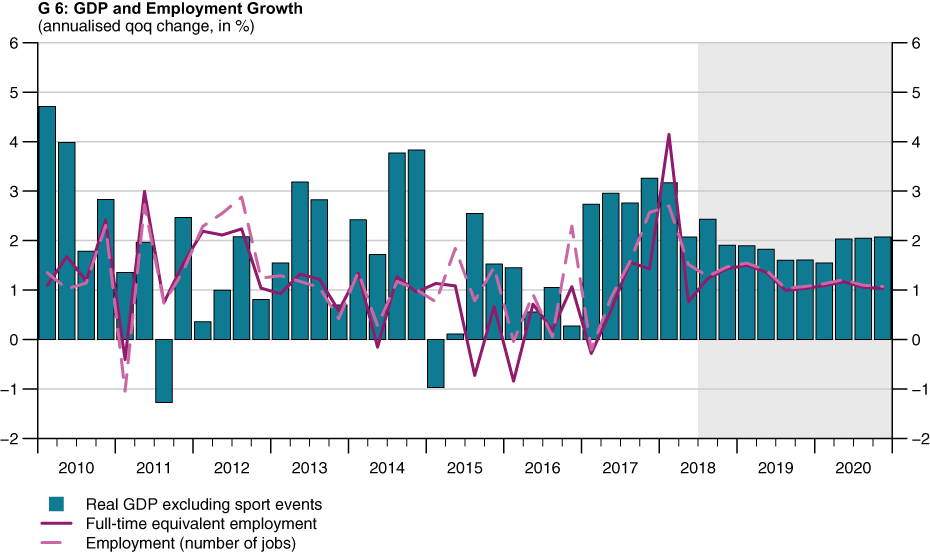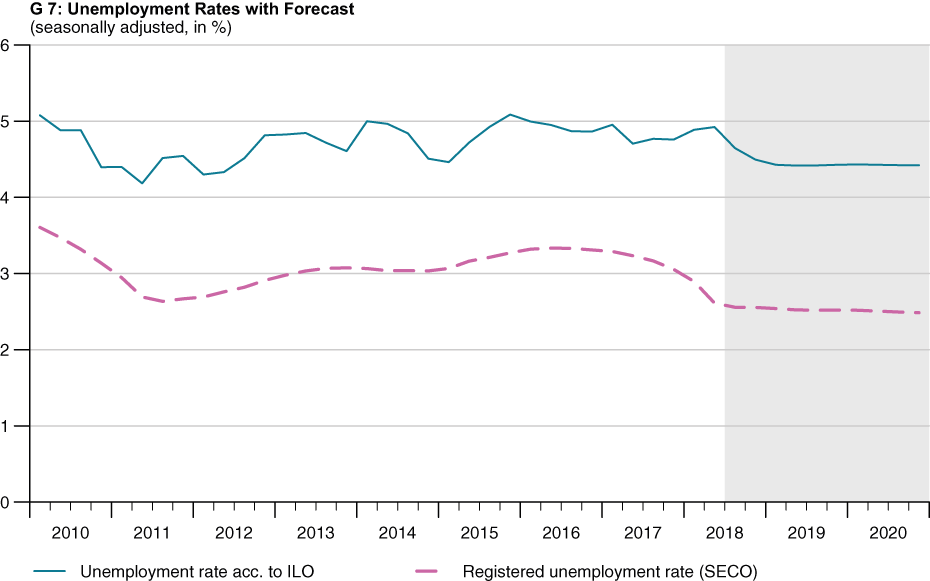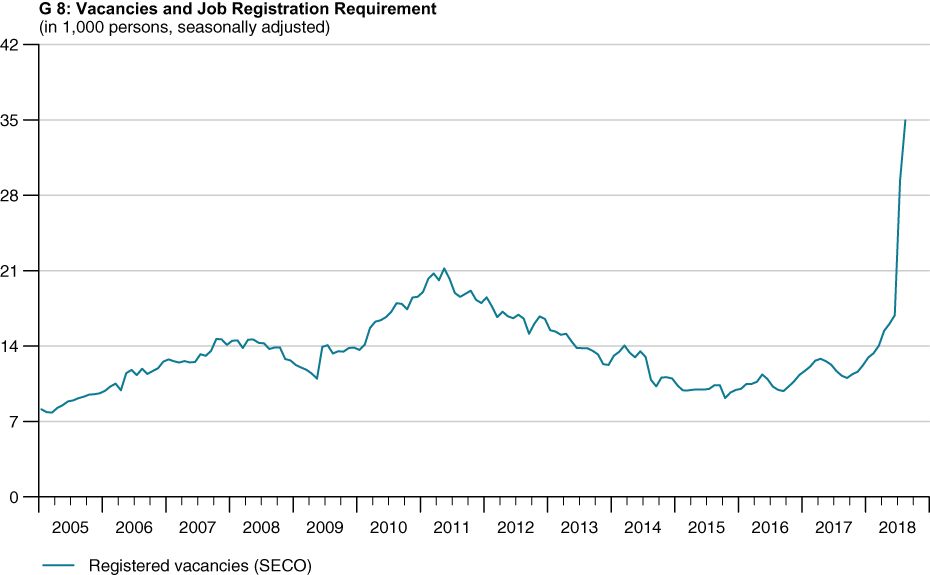Positive Trend on the Labour Market
- Labour Market
- KOF Bulletin
- KOF Economic Forecasts
The Swiss labour market is following a positive trend. According to the KOF forecast, the unemployment rate will remain low and will even decline slightly. The impact of the new job registration requirement is as yet unclear.
According to the revised employment statistics of the Federal Statistical Office (FSO), the Swiss labour market has delivered a solid first six months, as expected. On a seasonally adjusted basis, Swiss companies have created 47,000 new full-time equivalent (FE) jobs since the end of last year. The service sector was responsible for the majority of the new jobs: hotels and restaurants, freelance, science and technology services as well as healthcare and social welfare expanded considerably. The watch industry also created scores of new positions. Although the employment statistics compiled by the FSO every quarter on the basis of the Swiss Labour Force Survey (SLFS) paint a slightly less euphoric picture of the Swiss labour market in the past half year, its data also indicate a seasonally adjusted rise in employment of just under 33,000 jobholders since the end of the last year.
The short-term outlook for the labour market remains positive. According to the majority of the relevant Swiss labour market indicators, companies are still looking to create further jobs. When the KOF Employment Indicator broke through the five-point mark in August, it did so for the first time in over seven years. A further rise from a rather high level was also recorded by the FSO employment indicator, which is also calculated on the basis of company surveys. According to the FSO vacancy indicator, companies’ propensity to create new positions has also resulted in a large number of vacancies in the recent past. In its autumn forecast, KOF anticipates a continuation of the previous quarter’s above-average growth in FTE employment over the coming four quarters (see G 6). For the full year, KOF expects a 1.9% increase in FTE employment over the previous year. Next year, growth should be around 1.3%. Our forecast for employment growth in 2019 is +1.4%.

Is unemployment pursuant to ILO also on the decline?
Despite the considerable increase in jobs in the last few months, the Swiss unemployment rate has not really budged – at least according to the jobless statistics of the FSO which are calculated in line with the International Labor Organization (ILO) standards (see G 7). The registered unemployment rate has dropped significantly in the last few months. To a large degree, this is due to a technical conversion of the method used to record the number of registered unemployed. Nevertheless, even if this special effect is excluded, the monthly registered unemployment figures indicate a decline in unemployment. By contrast, the unemployment rate according to the ILO has gone up slightly in the past few months. We believe that this discrepancy will average out over the next few quarters and that the ILO unemployment rate will also decline to some extent. It is however true that the ILO rate has been very persistent in the last few years: Its correlation with the economic trend has been rather low and the rate has remained above 4% even when the economy was doing well. We therefore anticipate no more than a moderate decline in the seasonally adjusted ILO unemployment rate in the coming quarters, projecting a drop from currently 4.9% to approximately 4.5% by late January. For 2019, we expect an average rate of 4.4%. The forecast for registered unemployment in the coming year is relatively low at 2.5%.

Job registration requirement leads to threefold increase in number of registered jobs
The new job registration requirement represents an unknown factor in the calculation of the above unemployment forecasts. Since July 2018, companies advertising jobs in professions with unemployment rates in excess of 8% are required to register their vacancies on the job platform of the Swiss unemployment insurance scheme. On top of this, the jobs must be advertised exclusively on this platform during a waiting period of five days. Companies must consider any jobseekers’ files sent by regional employment offices (RAV) and invite suitable candidates. At the moment, the registration requirement applies to 19 professional categories mainly in the construction industry, hotel and catering, personnel services and agriculture. This will change in 2020 when the threshold will be lowered to an unemployment rate of 5% and the number of advertised jobs subject to the registration requirement will go up substantially.
The next few quarters will show whether the job registration requirement will lead to the desired higher exhaustion of the domestic labour supply and lower unemployment in the respective professions. For the moment, the legislator is encouraged by the fact that many companies appear to comply with the new registration requirement. In July and August, the number of vacancies registered with the regional employment offices almost tripled compared to the preceding months (see G 8). This increase is more substantial than expected. In the absence of empirical evidence relating to job registration requirements or experience values from similar measures in other countries, our forecast ignores any possible effects of the job registration requirement on the unemployment rate. Consequently, the requirement represents a certain forecast risk, especially for the 2020 forecast when the job registration requirement will become more extensive.

Contact
KOF Konjunkturforschungsstelle
Leonhardstrasse 21
8092
Zürich
Switzerland